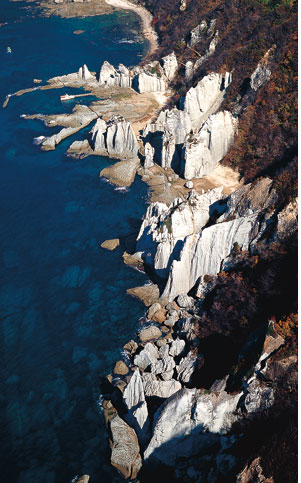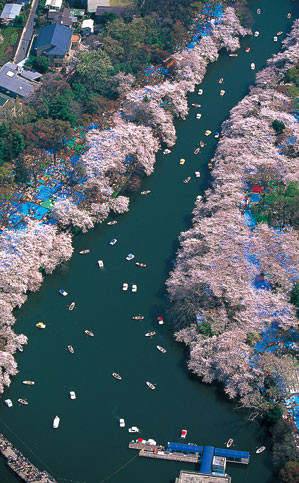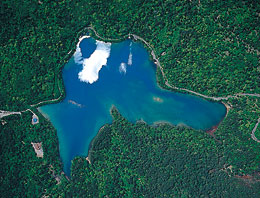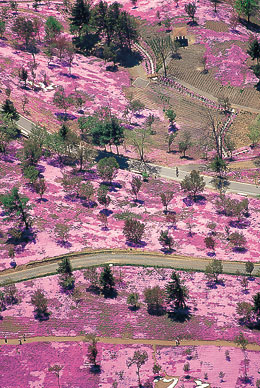Nature in Japan
Colors and Shapes, by Nature
Each passing season brings a new set of colors. Waves, wind and rain carve the land into curious shapes. While exploring the natural world in Japan, our aerial photographers discovered some beautiful colors and interesting topographical features.


Hotoke-ga-ura
Above left: Unusual white rock formations confront the blue sea. The larger ones, some rising about 80 meters above the water, have names associated with Buddha—names like Nyorai no Kubi (Neck of the Nyorai Buddha), Kannon Iwa (Rock of the Bodhisattva Kannon), and Jizo Iwa (Rock of the Bodhisattva Jizo). The three-kilometer coast, on the western side of the Shimokita Peninsula in Aomori Prefecture, is called Hotoke ga Ura (Buddha's Seashore). Indeed, the rough waves of the Tsugaru Strait here have carved the rocks into shapes that look a little like Buddhist statues.
(Photo: Watanabe Manabu)
Cherry blossoms, Inokashira Park
Above right: For the Japanese, the biggest event in spring may be going to see the cherry blossoms. Inokashira Park is considered the best place to see them in Tokyo. Some of its 600 magnificent cherry trees lean over the small lake, adding to the enjoyment of people in rowboats. This is a time to eat, drink and be merry, and in this photo you can almost hear the voices of people drunk on the sight of the blossoms.
(Photo: Toyotaka Ryuzo)

Lake On'neto
Mount Meakandake in Ashoro, Hokkaido, is an active volcano, and one of its eruptions dammed a river and formed this lake. On'neto means "Our Parents' Lake" in the language of the indigenous Ainu people. Surrounded by a green forest, the lake shimmers with a mysterious deep blue.
(Photo: Watanabe Manabu)

Moss pinks, Takinoue Park
It is springtime in the north country, and a dark pink carpet covers a hill in Takinoue Park (town of Takinoue, Hokkaido). Moss pinks (a type of phlox) were planted over an area of about 100,000 square meters on the hill. The flowers all bloom at the same time, beginning in May, and the Moss Pink Festival lasts until early June. One tourist attraction is a helicopter ride to see the "carpet" from the air.
(Photo: Toyotaka Ryuzo)